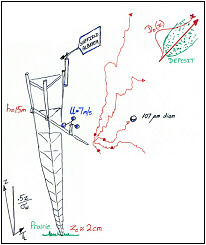 Heavy Particle Trajectories
Heavy Particle Trajectories Heavy Particle Trajectories
Heavy Particle Trajectories
The simplest Random Flight models for the paths of heavy particles in turbulence have been tested against previous observations of the deposition of glass beads from an elevated source in the atmospheric surface layer. For the bead sizes examined (diameter 50 -100 Ám), for which the ratio of particle inertial timescale to turbulence timescale tp/ TL << 1, it was found sufficient to adapt, as others earlier have done, a well-mixed 1st-order Lagrangian Stochastic ("Langevin") model of fluid element trajectories, simply by superposing a gravitational settling velocity wg , and reducing the velocity auto-correlation timescale along the heavy particle trajectory ( Tp) relative to the fluid-Lagrangian timescale ( TL). That is to say, unless details of the particle distribution very close to ground (where tp/ TL is not small) are of interest, no advantage other than conceptual clarity can be found in the more faithful approach of explicitly modeling particle acceleration, by means of the particle equation of motion.
With the timescale reduction parameter b ~ 2, the Langevin model estimated the location and width of the bead deposit swath quite well, and fixed the peak deposit density to within (at worst) about 100% error (in very stable stratification), but more generally to within about 20%. In the case where trajectories intersected a tall crop canopy, uncertainties in the treatment of deposition proved more significant than nuances of the trajectory algorithm.